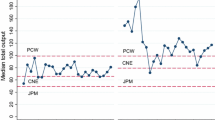Abstract
A competitive learning model was introduced in Mehta and Luck (Phys Rev E 60, 5:5218–5230, 1999), in which the learning is outcome-related. Every individual chooses between a pair of existing strategies or types, guided by a combination of two factors: tendency to conform to the local majority, and a preference for the type with higher perceived success among its neighbors, based on their relative outcomes. Here, an extension of the interfacial model of Mehta and Luck (Phys Rev E 60, 5:5218–5230, 1999) is proposed, in which individuals additionally take into account their own outcomes in arriving at their outcome-based choices. Three possible update rules for handling bulk sites are considered. The corresponding phase diagrams, obtained at coexistence, show systematic departures from the original interfacial model. Possible relationships of these variants with the cooperative model of Mehta and Luck (Phys Rev E 60, 5:5218–5230, 1999) are also touched upon.
















Similar content being viewed by others
References
Bala V, Goyal S (1998) Learning from neighbours. Rev Econ Stud 65:595–622
Barros K, Krapvisky PL, Redner S (2009) Freezing into stripe states in two-dimensional ferromagnets and crossing probabilities in critical percolation. Phys Rev E 80:040401
Bisin A, Verdier T (2001) The economics of cultural transmission and the dynamics of preferences. J Econ Theory 97:298–319
Castellano C, Fortunato S, Loreto V (2009) Statistical physics of social dynamics. Rev Mod Phys 81:591–646
Chatterjee K, Xu SH (2004) Technology diffusion by learning from neighbours. Adv Appl Probab 355(376):355–376
Christensen K, Moloney NR (2005) Complexity and criticality. Imperial College Press, London
Conley TG, Udry CR (2000) Learning about a new technology: pineapple growers in Ghana. Mimeo Northwestern and Yale Universities
de Oliveira MJ, Mendes JFF, Santos MA (1993) Nonequilibrium spin models with Ising universal behaviour. J Phys A 26:2317–2324
Dornic I, Chaté H, Chave J, Hinrichsen H (2001) Critical coarsening without surface tension: the universality class of the voter model. Phys Rev Lett 87(4)045701
Drouffe JM, Godrèche C (1999) Phase ordering and persistence in a class of stochastic processes interpolating between the Ising and voter models. J Phys A 32:249–261
Ellison G, Fudenberg D (1995) Word-of-mouth communication and social learning. Q J Econ 110:93–125
Eshel I, Samuelson L, Shaked A (1998) Altruists, Egoists and Hooligans in a local interaction model. Am Econ Rev 88:157–179
Frachebourg L, Krapivsky PL (1996) Exact results for kinetics of catalytic reactions. Phys Rev E 53:R3009–R3012
Glauber RJ (1963) Time-dependent statistics of the Ising model. J Math Phys 4:294–307
Holley R, Liggett T (1975) Ergodic theorems for weakly interacting infinite systems and the voter model. Ann Probab 3:643–663
Landau D, Binder K (2005) A guide to Monte Carlo simulations in statistical physics. Cambridge University Press, Cambridge
Mehta A, Luck JM (1999) Models of competitive learning: complex dynamics, intermittent conversions, and oscillatory coarsening. Phys Rev E 60(5):5218–5230
Smith MA, Ghazizadeh A, Shadmehr R (2006) Interacting adaptive processes with different timescales underlie short-term motor learning. PLoS Biol 4:e179
Spirin V, Krapivsky PL, Redner S (2001) Freezing in Ising ferromagnets. Phys Rev E 65(016119):1–9
Spirin V, Krapivsky PL, Redner S (2001) Fate of zero-temperature Ising ferromagnets. Phys Rev E 63(036118):1–4
Acknowledgments
G.M. would like to thank Nirmal Thyagu for helpful discussions in the course of this study. G.M. was supported by a grant from DST (Govt. of India) through the project “Generativity in Cognitive Networks.”
Author information
Authors and Affiliations
Corresponding author
Rights and permissions
About this article
Cite this article
Mahajan, G., Mehta, A. Competing with oneself: introducing self-interaction in a model of competitive learning. Theory Biosci. 129, 271–282 (2010). https://doi.org/10.1007/s12064-010-0111-y
Received:
Accepted:
Published:
Issue Date:
DOI: https://doi.org/10.1007/s12064-010-0111-y




